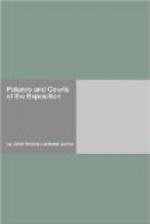Here is that fine feeling that one has in beautiful springtime — the adoration for all fresh young life. Look above now at Milton Bancroft’s murals to left and right. He has painted all of the murals in this court.
“Spring” is here in floral dress and the shepherd pipes sweet notes.
“Seed-time” — This is the time when the seed bag stands open so that the crops for the coming year may be sown.
-
Marble group of Summer — Go to the left, along the corridor beyond the gateway, to the second niche — this group expresses fruition.
The mother brings to her husband the babe, the fruit of their love.
The laborer at the right brings in the first harvest.
-
Murals
Summer — This is the period of the year when man amuses himself, when the games are in progress. One sees the disc thrower at the left resting after the game. Summer is crowning the victor of the canoe race.
Fruition — Fruits, vegetables, flowers fulfill the meaning of the subject.
-
Now pass out into the open to the niche at the left of the gateway of the east.
In the niche is Autumn, a mature figure indicative of the maturity of the year. (Mr. Piccirilli calls her Providence.) It is the time of the harvests. The apples, the grapes, and even the human family are being harvested. The wine is being made and the great vine-decked jars are filled with the ruby fluid.
-
Murals
Autumn — The colors speak of autumn. Here is seen the amphora of wine, the tambourine, the rhyton, the Greek drinking horn, and the raised Greek cup — all suggesting the time of festivity after the harvests.
Harvest, and one sees the garnered wheat and vegetables.
-
Standing between the two central columns and looking toward the half dome, the eye wanders to the summit, and there, seated on her great cornucopia, the symbol of abundance, is Harvest with her plenteous supply of luscious fruits.
The dates from the south are being borne in on one side, while the great sheaves of wheat are seen on the left.
-
Standing on the pedestal at the right of the half dome is Rain (by Albert Jaegers) catching the drops in her shell.
Sunshine (by Albert Jaegers) shielding her eyes with the long palm branch — the rain and the sunshine so necessary for the harvests.
Walk over to see the detail of the capitals and bases of the columns.
On the capitals of these pedestals, on which Rain and Sunshine stand, are the small figures of harvesters — a most charming, original treatment.
At the bases one sees harvest scenes.
The agriculturists pass along to their labors. The women and children accompany the laborers, expecting to help in the many duties of the harvest field. The dog, wagging his tail, follows after the children, and all is activity.




